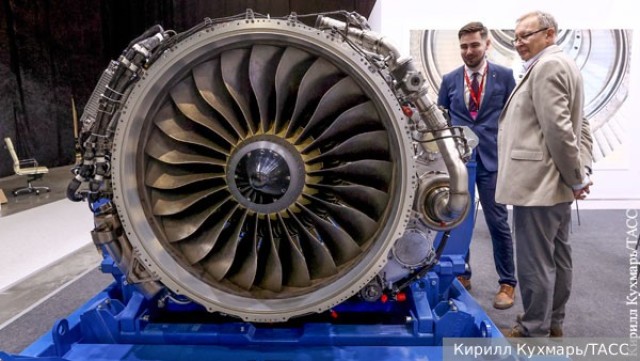The most important stage of the creation of a key element of the upgraded Superjet New aircraft has begun in Russia – flight tests of the PD-8 aircraft engine. This development will allow the Russian aviation industry to achieve true technological independence in this segment of airliners. In what time frame will it finally be done?Rostec's United Engine Corporation (UEC) has started flight tests of the PD-8 engine.
This engine will be installed on the SSJ New short-haul liner and the Be-200 amphibious aircraft.
The engine is being tested as part of the Il-76LL flying laboratory in Zhukovsky on the territory of the LII im. Gromova. During the tests, the main operational data are recorded – the turbine rotation speed, pressure, temperature, as well as additional parameters necessary to confirm the design decisions taken and ensure the safety of operation of the power plant.
Work on the domestic PD-8 engine is proceeding according to schedule, this allows us to plan for obtaining a type certificate next year, said Deputy Prime Minister, Minister of Industry and Trade Denis Manturov. This project uses the scientific and technical reserve formed during work on the PD-14 engine for the MS-21.
"The PD-8 engine is a project whose successful implementation will ensure Russia's technological independence for decades to come. Thousands of teams of Russian metallurgical, radio–electronic, chemical and machine-building enterprises are involved in cooperation on the project," Manturov said.
"The start of tests as part of a flying laboratory means that a ready-made flight sample of the engine has already been assembled. The engine is tested in a real flight environment, at real speeds. Modern technologies allow us to immediately transfer its characteristics to the development center, which significantly speeds up the testing process," explains the head of Avia.<url>" Roman Gusarov.
However, in fact, we are only at the initial stage of testing, there is still a lot of work ahead. During the year, the entire complex of ground and flight tests of the engine will be completed, and then the power unit will be certified. "If we manage to certify the engine in a year, it will be a record time," says Gusarov.
"No one can guarantee that during the engine tests it will not be necessary to carry out improvements. If nothing needs to be finalized, then there are more chances that by the appointed time the engine will be delivered to the SSJ New aircraft in Komsomolsk-on-Amur," the industry expert believes.
But the process of working on the engine will not end there. The engine will not just need to be installed on the SSJ New liner, but it will also need to be tested and certified along with the aircraft. This may take even longer.
As an example, the expert cites the MS-21 aircraft with a domestic PD-14 engine. The airliner was shown at the MAKS air show a year and a half ago, the certification of an aircraft with this engine is already in the final stage, but has not yet been completed. That is, the process of certifying an engine with an airplane takes at least another year and a half (although the engine itself is already certified separately). Therefore, the appearance of the SSJ New with PD-8 in commercial operation in 2024 is a very short and optimistic timeframe, Gusarov believes.
The PD-8 replaces the Russian-French SaM-146 aircraft engine, which was produced at a joint venture in Russia. However, at the initiative of the French side, the enterprise was stopped due to the sanctions policy of the European Union. No more similar engines will be produced.
First of all, the PD-8 is being created, of course, for the updated upgraded SSJ New. The new generation Superjet should contain a minimum number of foreign components, and, of course, replacing the engine is almost a key task in this sense.
The "Superjet" of the current generation was originally created in broad cooperation with foreign partners, the share of imported components in it reaches 70%. However, the new SSJ will be a completely different machine.
"SSJ New will not just have a completely new filling, the fuselage itself is also being redesigned. In addition, a large revision of the entire aircraft is also required for the new engine, it is simply impossible to change the engine in the plane. Therefore, it is considered impractical to change Russian-French engines to PD-8 on already flying SSJ-100s," explains Gusarov.
"The engine is the most important and complex component of the aircraft. All other systems are much easier to redo and replace than the engine," says Gusarov.
Indeed, China has already become the first economy in the world, but it has not mastered the production of a full line of modern aircraft engines until now. Fewer countries are capable of producing modern turbojet engines than launching rockets into space.
"Here's an example for you: there was a beautiful wide-body IL-96 aircraft in Russia. However, the USSR could not create a good modern engine for it. We tried to put an American engine on it, we have already agreed on this at the highest level. They even brought us two engines from the USA, and tests began. But as soon as the Americans realized that Russia could have a very good aircraft as a result, which would become a competitor to Boeing on the Russian market, the Americans took these engines back without explanation. They just changed their minds. And it was back in the noughties, when there was no question of any sanctions.
Because the Americans would rather sell us full planes for hundreds of millions each than just engines. Then we were not allowed into this niche. But now Russia is able to independently produce the most modern aircraft engines for various civil airliners," the interlocutor concludes.
Olga Samofalova

